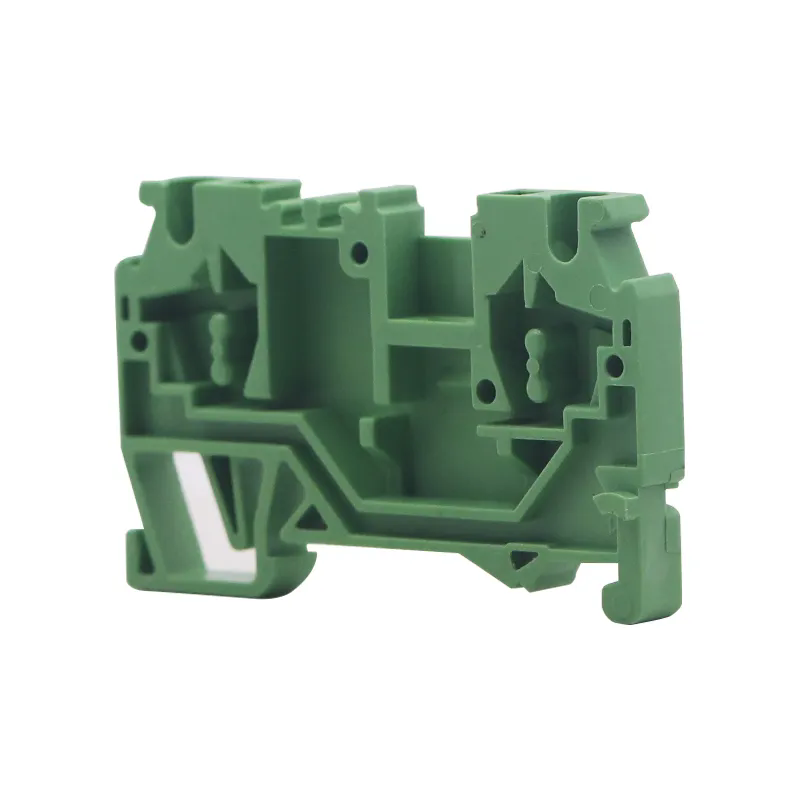What Are DIN Rail Terminal Blocks and Why Are They Essential for Electrical Systems?
2024-11-15
When working with electrical panels or control systems, you’ll likely encounter DIN rail terminal blocks. But what exactly are these components, and why are they so important in electrical installations? If you’re wondering how these small but mighty parts fit into larger electrical systems, you’ve come to the right place. Let’s explore the role of DIN rail terminal blocks, their benefits, and why they’re essential for reliable and efficient electrical wiring.
What Is a DIN Rail Terminal Block?
A DIN rail terminal block is an electrical component used to connect and organize wiring in control panels, machinery, and electrical enclosures. These terminal blocks are mounted onto DIN rails, which are standardized metal rails that provide a simple and secure mounting solution for various electrical devices. Terminal blocks themselves are used to secure the ends of electrical wires, ensuring that connections are both safe and easily accessible.
DIN rail terminal blocks are commonly used in industrial, commercial, and residential electrical systems. They allow for neat, organized, and reliable electrical connections, which is essential for both safety and efficiency.
1. What Are the Main Types of DIN Rail Terminal Blocks?
There are several different types of DIN rail terminal blocks, each designed to meet specific electrical needs. Some common types include:
- Feed-Through Terminal Blocks: These are used to connect two or more wires of the same type or function. They allow for a simple, straight-through connection between wires.
- Junction Terminal Blocks: These blocks are used to combine or distribute multiple wires. They are perfect for connecting wires of different functions or routing power to different components.
- Grounding Terminal Blocks: These terminal blocks are specifically designed for connecting ground wires to ensure safety and prevent electrical hazards.
- Fuse Terminal Blocks: These blocks integrate a fuse directly into the terminal block, providing overcurrent protection for circuits.
- Bridge Terminal Blocks: These blocks allow for quick connection between multiple terminals with a jumper or bridge, simplifying wiring in complex systems.
Each type of terminal block has a specific role and is designed to make certain wiring tasks easier, more efficient, and more secure.
2. Why Are DIN Rail Terminal Blocks So Popular?
DIN rail terminal blocks are widely used in a variety of industries, and their popularity can be attributed to several factors:
- Standardized Design: The use of DIN rails for mounting terminal blocks is a standardized practice, making them easy to integrate into existing systems and designs. This ensures compatibility across different devices and manufacturers.
- Organized Wiring: Terminal blocks allow for clear, organized wiring by grouping connections together and reducing the risk of messy or disorganized installations. This leads to more efficient troubleshooting and maintenance.
- Safety and Reliability: These blocks provide secure, insulated connections, reducing the risk of short circuits, electrical faults, or accidental disconnections. Properly mounted terminal blocks ensure that wires are firmly held in place, minimizing the chance of vibration-induced loosening.
- Easy Installation and Maintenance: Since DIN rails provide a quick and secure way to mount terminal blocks, installations are faster and easier. In addition, wiring connections can be easily modified or updated as necessary.
- Versatility: DIN rail terminal blocks come in various designs and configurations, allowing them to be used in a wide range of applications, from control panels and distribution boards to machinery and automation systems.
3. How Do DIN Rail Terminal Blocks Contribute to System Efficiency?
The efficiency of an electrical system can be greatly improved with the use of DIN rail terminal blocks. Here’s how they contribute to both functional and operational efficiency:
- Streamlined Wiring: By organizing connections into neat, labeled rows, terminal blocks make wiring easier to follow and less prone to errors. This streamlined design reduces wiring complexity and improves overall system efficiency.
- Improved Troubleshooting: When a system is properly organized, identifying faults or issues becomes much simpler. With clearly marked terminal blocks and easy access to connections, diagnosing and repairing electrical problems is faster and more straightforward.
- Reduced Downtime: Because terminal blocks provide a secure and organized method for wiring, there’s less risk of connection failure, which can lead to unplanned downtime. In industrial and commercial applications, this means higher productivity and fewer interruptions to normal operations.
- Scalability: DIN rail-mounted terminal blocks can easily be expanded to accommodate additional connections as systems grow. This flexibility allows for future-proof designs, making it easier to scale systems as new devices are added or needs change.
4. Where Are DIN Rail Terminal Blocks Used?
DIN rail terminal blocks are used in a variety of industries and applications, including:
- Industrial Control Panels: In control panels, terminal blocks are used to connect power lines, sensors, and control devices.
- Automation Systems: Terminal blocks help organize wiring in automated systems, making it easier to wire and configure PLCs (programmable logic controllers), relays, and other automation components.
- Machinery: In large machines and equipment, terminal blocks are used for distributing power to various components, ensuring a reliable and organized wiring system.
- Electrical Distribution: Terminal blocks are used in distribution boards and fuse boxes to ensure proper connection and distribution of electricity throughout a building or facility.
- Renewable Energy Systems: In solar and wind energy systems, DIN rail terminal blocks are used to wire various components, such as inverters and charge controllers, safely and efficiently.
5. What Are the Key Benefits of Using DIN Rail Terminal Blocks?
Using DIN rail terminal blocks provides several key benefits:
- Safety: By securely connecting wires and preventing loose connections, terminal blocks reduce the risk of electrical hazards, such as short circuits or fires.
- Cost-Effective: The standardized design of DIN rail terminal blocks makes them an affordable and cost-effective option for electrical installations, reducing labor costs and minimizing the need for specialized tools.
- Ease of Use: Installation and maintenance of DIN rail terminal blocks are simple and require minimal effort, making them ideal for both professionals and DIY enthusiasts.
- Durability: Made from high-quality materials, DIN rail terminal blocks are durable and built to withstand the rigors of industrial environments, offering long-lasting performance.
Conclusion
DIN rail terminal blocks are integral components in modern electrical systems, providing a secure, organized, and efficient way to manage wiring connections. Whether you're designing a control panel, working with industrial machinery, or upgrading your electrical distribution system, these versatile components offer numerous benefits in terms of safety, efficiency, and reliability. By using DIN rail terminal blocks, you can ensure that your electrical connections remain secure, accessible, and well-organized, ultimately improving the overall performance of your system.



